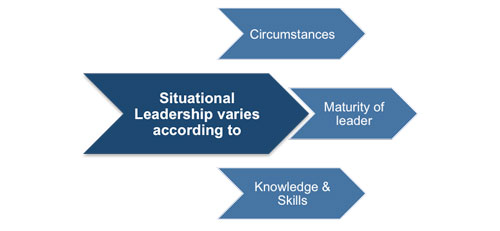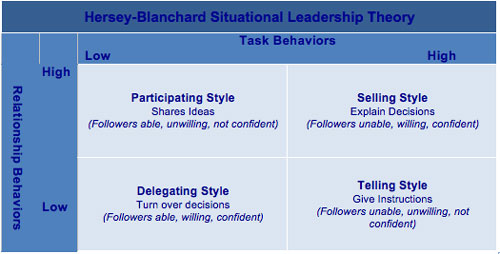Hersey-Blanchard Situational Leadership Theory
Right in the name of this leadership theory, you can get a great indication of what it is all about. The term 'situational' indicates that leaders should vary their approach based on the people they are leading, and the circumstances that surround the task at hand. Indeed, the Hersey-Blanchard Situational Leadership Theory is one that is based around variable leadership, depending on a variety of circumstances. When a leader is able to adapt to the situation as quickly as possible, everyone will benefit in the end.
Specifically, this theory has to do with the maturity of those who are being led. To those who have worked as leaders in the past, it is no surprise that maturity should be considered when working on finding the right leadership style. For example, someone who is inexperienced in their field will likely lack the skills or confidence to take on tasks that would be comfortable for a more experienced employee.
 |
Only when a leader is able to mold their approach to the maturity and talent of those that make up the team will the overall performance be up to par.
The Situational Leadership Theory offers up four potential leadership styles, and then four maturity levels that define the members of a team. Let's quickly look at each of the four styles and levels that can then be paired up for optimal performance.
 |
Four Leadership Styles
The four leadership styles that are presented in this theory are Telling, Selling, Participating, and Delegating. Starting with Telling, this is the most direct form of leadership. The leader of the group simply tells each member what to do, and how they would like them to do it. This approach is less collaborative, and more directive in nature. There is very little working together between the leader and the team members, instead the leader simply provides specific instructions for the team members to follow through with.
The second leadership style, Selling, is one with a little more room for collaboration. While the team members are still directed by the leader, the leader is more likely to engage with the team members along the way. The 'Selling' title comes from the idea that the leader may need to convince some of the team members to follow his or her lead and do things in a specific way.
Moving on to the third option, Participating is a process where the leader tries to build relationships with those on the team - really becoming part of the team. This is quite a departure from the Telling style, as the leader will blend in more fully with those who are working as part of the team. In fact, the leader might not even make all of the decisions in this style, perhaps deferring at certain points to members of the team with more experience or knowledge in a given area.
Finally, Delegating represents the leader passing on most of the responsibilities for a given project or task to various members of the team. This style is something that leaders of experienced teams will often use, since the employees that are being led may not need much in the way of direction at this point in their careers.
Four Corresponding Maturity Levels
To go along with those four leadership styles, the Hersey Blanchard Situational Leadership Theory also provides four maturity levels that describe those who are making up the team. To identify these levels, the abbreviations M1, M2, M3, and M4 are used. Below is a quick description of each of these four levels.
• M1. These are the least experienced of workers. At this point, they will need to be instructed on how to do just about everything that makes up the task they are responsible for. While this usually means a leader is dealing with younger and less experienced employees, it could also be that the employees simply don't have much knowledge or background in the task at hand for a specific project. This maturity level matches up with the Telling leadership style, as the employees at this point will require complete direction for almost every task.
• M2. Moving up a step, these are still inexperienced people who possess only slightly more knowledge and skill than those at the M1 level. Maturity is not only a measure of the ability than an individual has to deal with a task, but their willingness to take on the task in the first place. M2 team members are those who are more eager to work on a job, even if they aren't yet ready to do it correctly without the help of the leader of the group. The Selling leadership style is the proper match when dealing with M2 level team members.
• M3. Getting close to the top of the scale, this group would include employees who are excited to work on a job and have most of the skill they need to get it done right. While they might not be able to quite get all of the job done without some help, they can get most of the way their on their own. The Participating style is the one that matches with M3 individuals, because they don't need full direction and are more able to engage with the leader for positive collaboration.
• M4. At the top of the scale, those that are rated as M4 are completely capable of handling a task - and they know that they can get the job done without the help of the leader. Delegating is the leadership style of choice at this point simply because there is no need to be more involved than that. The team members have confidence, and expect to work independently.
The Hersey Blanchard Situational Leadership Theory promotes flexible leaders that are able to match their style to the experience and ability of those they are leading. Most people would agree that a good leader is a flexible one, and this theory falls right in line with that manner of thinking.
You may also be interested in:
Action Centered Leadership | Blake-Mouton Managerial Grid | Dunham and Pierce's Leadership Process Model | Fiedler's Contingency Model | French and Raven's Five Forms of Power | Hersey-Blanchard Situational Leadership Theory | Tannenbaum-Schmidt Leadership Continuum | Lewin's Leadership Styles Framework | Path-Goal Theory | Zenger and Folkman's 10 Fatal Leadership Flaws.



